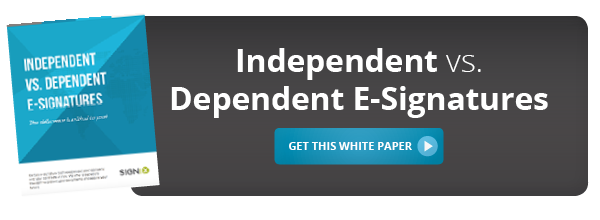When you're picking an e-signature vendor, there's one critical question you have to ask yourself:
Can this service prove that the document has not been altered since the signing and that it remains valid over time?
However, e-signature companies vary widely in how they prove the validity of an e-signature over time. One key to ensuring that an electronic signature remains valid over time is to capitalize on the difference between dependent and independent electronic signatures. With dependent signatures, verifying the legality of an e-signature requires a link to the e-signature vendor’s website or server.
Will the technology be the same in ten years when you have to prove that signature in court? Technology changes, services come and go. The service you choose should create signatures that can outlast technology trends.
Independent E-Signature Technology Gives You:
- Ownership and Control: The user of Independent E-Signature technology controls where signed documents reside, which can be limited to the user’s server, if preferred, with no copies under the vendor’s control or ownership. In addition, Independent E-Signatures feature offline verification at anytime, because the evidence behind the signature is embedded in the signed document.
- Longevity: Independent E-Signatures are valid forever because they adhere to international, published standards, which will always be discoverable, even if they fall into disuse – versus the private, proprietary standards used by dependent e-signatures, which can be irretrievably lost because they exist outside the public domain.
- Transparency: Independent E-Signatures provide the user with immediate and complete access to the evidence supporting their validity. In contrast, dependent e-signature vendors decide what evidence to share with users, and much of that information is hidden.
- Safety: Independent E-Signatures carry a much lower level of risk than dependent e-signatures because of all of the preceding benefits: 1) Ownership and control reduces the risk of outside parties sabotaging an e-signature’s validity. 2) Adherence to international standards reduces the risk of unforeseen external factors affecting an e-signature’s validity. 3) Complete access to e-signature evidence reduces the risk of unknown or hidden factors making an e-signature invalid.



